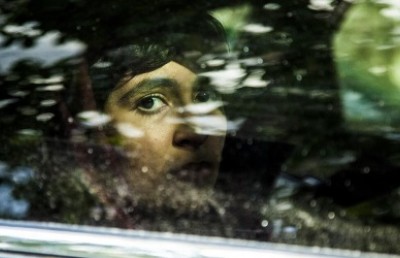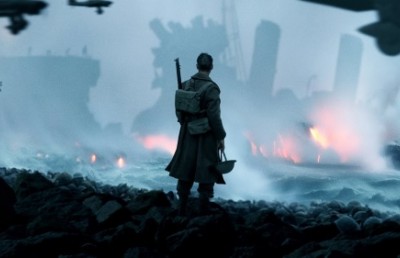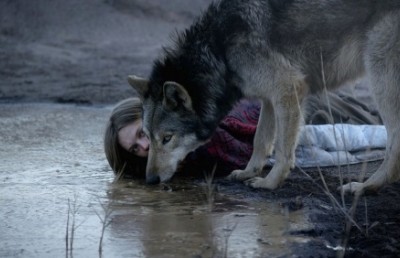TIFF 2017: Beyond the Unpleasure Principle
Experimental Cinema at Toronto

Notwithstanding such commercial avant-gardists as Carl Theodor Dreyer, Ozu Yasujiro, and Jacques Tati (to cite only the first three names that come to mind), the term experimental film customarily connotes a rejection, not just of the classicism of Hollywood cinema, but of narrative in general. Needless to say, story is not the only way for a film to engage an audience, but the rejection of narrative is not a virtue in itself—or, as Naomi Klein might put it, no is not enough.
Pedro Pinho’s The Nothing Factory—which was the opening night film for this year’s Wavelengths program at the Toronto International Film Festival (TIFF)—is a case in point. To be sure, this nearly three-hour film tells a story; the problem is that Pinho is evidently uninterested in eliciting the viewer’s sympathy for his characters, most of whom work in a factory that manufactures elevators. As the factory does not have enough orders to make it economically viable, the owners have the machinery removed secretly in the middle of the night and offer the workers a payout if they agree to quit, though a few, who are too stubborn to take the cash, continue to show up for work even though there is nothing for them to do. One can easily imagine a film on this subject along the lines of Michael Moore’s Roger & Me (1989), focusing on the personal toll the factory’s closure takes on the workers and other members of the community, but as Pinho appears to think that too much emotion would muddy his Marxist analysis of the workers’ dilemma, he opts instead to dwell at length on shapeless scenes in which the holdouts sit around and squabble about tactics. Then, to add a touch of Brechtian self-reflexivity, the film introduces an unkempt leftist intellectual (imagine a fatter, beardier, less entertaining Slavoj Žižek) who increasingly seems to be staging the workers’ sit-in as an amateur musical. Yet despite boasting some of the clumsiest choreography I have ever seen, the film’s big song and dance number fails to convey any sense of euphoria; rather, it is purely an intellectual gesture designed to puncture the verisimilitude of the film’s settings and performances. In short, Pinho does not appear to understand that in order for agit-prop to be effective it needs to agitate.
Like The Nothing Factory, Ben Russell’s Good Luck observes disempowered labourers from a privileged perspective, but where Pinho’s film is aridly intellectual, Russell’s is sensual to a fault. In lieu of a Marxist analysis of the effects of neoliberalism on the working class, this ethnographic diptych comparing Serbian copper miners with gold panners in Suriname submerges the viewer in the tactile realities of drilling and smashing rocks in the dark and walking and squatting in the mud. Political issues are not completely absent (the Serbians kvetch about the current government, while the men in Suriname lament that they could not finish their education due to the country’s civil war), but they take a backseat to the direct observation of manual labour. And while I am not certain that this was Russell’s intention, it is hard to escape the impression that the panners are just slightly better off than the miners, if only because they do not have to worry about being crushed to death. Plus, they get to work in the sunlight, and while one of the Serbians plays Neil Young’s “Heart of Gold” on the accordion in a black void, the panners put on a spirited hoedown using plastic buckets and beer bottles as instruments. All of Russell’s subjects seem like decent enough fellows, but as a result of the film’s non-narrative form and uncommunicative style (Russell often films his subjects from behind, blocking access to their facial expressions), one does not form a strong emotional attachment to them as one would in a classical narrative film. Accordingly, though I admired the film, I also felt somewhat excluded from it.

Good Luck
How then might a film engage an audience without the aid of a dramatic narrative? In contrast with Good Luck, where the connection between the film’s two segments is fairly obvious, some of the best short films in this year’s Wavelengths program bring together a range of seemingly unrelated materials and leave it to the viewer’s interpretation to forge associations between them. Dani Leventhal and Sheilah Wilson’s experimental home movie Strangely Ordinary This Devotion juxtaposes Leventhal putting a large rock in her mouth and having her scalp sliced open with a scalpel (apparently for real), Wilson coughing up gobs of blood on a white floor, explicit lesbian sex, a silly SF premise involving children who do not need water to live, and clips from Chantal Akerman’s Je tu il elle (1974) and Purple Rain (Albert Magnoli, 1984). Less viscerally unpleasant but no less enigmatic, Michael Robinson’s Onward Lossless Follows is a characteristically wry found footage mash-up incorporating stock images of women raising their arms triumphantly while sitting behind laptops, an audio clip of a southern pastor ranting about vapours on Venus, and an early 1990s PSA in which an apparently deranged middle-aged woman attempts to convince a boy named Karmi (yes, Karmi) to get into her van—a narrative Robinson embellishes with printed titles suggesting text messages that reveal a more complicated relationship between the two characters. Similarly, Fern Silva’s The Watchmen alternates between painterly images of an abandoned prison, various roadside dinners, and an outdoor screening of The Blues Brothers (John Landis, 1979), while Dane Kolmjen’s vaguely apocalyptic Fantasy Sentences progresses from 16mm home movies of family gatherings to eerily depopulated woodlands shot on ever more detailed digital formats. In all of these films, rather than piecing together a narrative, the viewer has to try to figure out how the various sounds and images fit together thematically—an open-ended process that may continue long after the films have ended.
There are times, however, when a little more context would be helpful. In some ways the most challenging feature in this year’s Wavelengths program, Narimane Mari’s nearly plotless Le Fort des fous consists of three largely self-contained segments, each set in a different location and period. The first section of the film is set in a 19th century colonial military academy in North Africa where the cadets pose for a European photographer while standing in formation, bayonetting dummies, and sitting in a classroom. Following some unspecified nautical disaster, the photographer and a lethargic senior officer wash up on a desolate shoreline, where they are taken in by a nomadic hippy collective of dancers and painters in modern dress. And in the film’s final segment, Mari juxtaposes talking head interviews with two contemporary Greek activists: an elegant upper-class woman who is never at a loss for words and is filmed in ritzy settings, and a young man who looks like a bum and is filmed alternately in a dilapidated shed and a dingy apartment where he rambles semi-coherently between long, insignificant pauses.
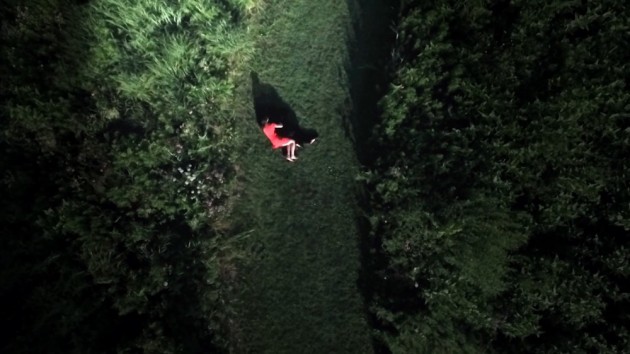
Strangely Ordinary This Devotion
For all its weirdness, the film’s first section cogently connects the history of European colonialism with the present day, at one point placing an historical text rationalizing foreign conquest—spoken in the film by a North African drill sergeant whose voice is garbled like the teacher in a Peanuts cartoon, though his words are printed clearly in the subtitles—alongside an audio clip of an even more offensive 2007 speech by Nicolas Sarkozy, who confidently asserts that “the African Man” has no history and is therefore incapable of making any sort of progress. (One can almost hear Edward Said rolling in his grave.) And while the second part of the film is more obscure, its dreamlike imagery is entrancing nonetheless. However, the interviews with the two activists simply bring the film to a dead halt. The film does not provide the viewer with any contextual information about who these people are or why Mari is interviewing them, and as they tend to speak in gaseous generalizations, it is extremely difficult for one to engage with the ideas they discuss. (While watching the film, I wondered if it was making fun of the rich woman’s radical posturing, which seemed to me completely divorced from concrete reality, but Mari’s comments in the post-screening Q&A suggested otherwise.) Although the film is not as empty as The Nothing Factory—far from it—like Pinho, Mari has a tendency to forget her audience.
While Le Fort des fous is obscure in a figurative sense, Blake Williams’ Prototype —which resembles a 3D remake of Numéro deux (Jean-Luc Godard, 1975) directed by David Lynch—is obscure in the sense that it is often difficult to tell precisely what it is that one is looking at. Opening with a series of archival stills documenting the aftermath of a hurricane that hit Galveston, Texas on September 7, 1900, the film consists primarily of murky black-and-white images of shadowy figures superimposed on top of one another and streaks of light on three bulbous, flickering TV screens that are suspended in a black void in various three-dimensional arrangements and are accompanied by the monotonous droning of the wind and the waves. Largely bypassing the viewer’s cognitive faculties, the film aims for an immediate, visceral response. But while the film is certainly affecting, like William’s Something Vertical (2015)—which gave me a terrific headache when I saw it at TIFF two years ago—I am not sure that it is an experience I wish to have again.
On the other hand, I am absolutely certain of having no desire to see Caniba, the new film by Lucien Castaing-Taylor and Véréna Paravel, ever again. While studying comparative literature at the Sorbonne in the early 1980s, the film’s subject, Sagawa Issei, murdered and cannibalized a female classmate, Renée Hartevelt, when she rejected his sexual advances. The French courts found Issei not guilty by reason of insanity, and since then he has lived in Tokyo with his brother, Jun, who has some unsavoury hobbies of his own. However, rather than eliciting sympathy for Issei (who suffers from an unspecified degenerative condition confining him to a wheelchair), the filmmakers go out of their way to show him in the most dehumanizing light possible, beginning with their decision to shoot the film exclusively in enormous handheld close-ups that emphasize the sickly textures of Issei’s skin and are out of focus more often than in. On top of this, the film treats the viewer to clips from Issei’s work as a fetish porn actor and an extended sequence in which Jun looks at a crudely drawn comic book that Issei authored relating his crimes in graphic detail. While reading the book, Jun repeatedly says he cannot stand to look at this “shit” any longer and then compulsively flips to the next page. And just in case one still has any lingering sympathy for him after this, the film dwells at great length on Jun cutting himself with knives and barbed wire. In one sequence, while stabbing himself in the arm with no less than four blades, he complains, “This isn’t fun yet!” But while there is a certain black humour in scenes like this that almost makes the film bearable, I really do not know why it needs to exist.
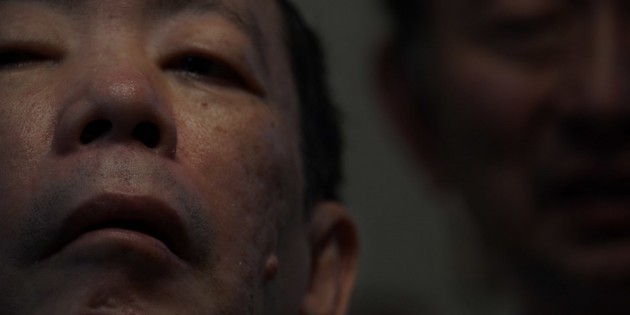
Caniba
Seeing Denis Côté’s Ta peau si lisse just twenty-four hours after Caniba reminded me of Godard’s observation that the best way to critique a film is to make another film. Profiling five Quebecois bodybuilders and a professional wrestler, the film views its subjects with a certain detached amusement without turning them into freaks. Like Russell, Côté often films his subjects from behind, and some shots—like the one of a teenage bodybuilder, Alexis Légaré, standing in his parents’ driveway while wearing a VR helmet—almost look like something out of an Ulrich Seidl film, though Côte’s compositions are never quite as rigidly symmetrical or as frontal as Seidl’s. However, while there is a lot of humour in the film, one also comes away from it with a great deal of respect for its subjects’ passion and discipline. (In one sequence, Légaré scolds his girlfriend for cheating on her exercise routine, telling her she can find the time to work out if she really wants to.) In terms of structure, Côté organizes his materials associatively, and while the links between some segments are fairly obvious (at one point, the film cuts from Légaré posing for his girlfriend in his backyard to an older man, Cédric Doyon, posing for an art class), others are more mysterious, inviting the viewer to tease out a connection between two seemingly unrelated scenes.

Ta peau si lisse
Closer to traditional narrative, Xu Bing’s Dragonfly Eyes uses found CCTV footage to tell a fictional story about a young woman, Qing Ting (voiced by Liu Yongfang), who after leaving a Buddhist monastery passes through a series of menial jobs before getting plastic surgery and finding fame as an internet cam girl, serenading lonely men in exchange for virtual “gifts.” (Of course, this being China, she keeps her clothes on.) Although the images come from all over the country, Xu creates a partial illusion of narrative continuity by having voice actors dub over the images somewhat in the manner of Woody Allen’s What’s Up, Tiger Lily? (1966). And while the viewer never completely forgets that one is looking at found footage, the use of multiple bodies to represent the same fictional character is not as jarring as it is in Luis Buñuel’s Cet obscur objet du désir (1977) as the onscreen figures are generally too far away, and the images too pixelated, for the viewer to make out their faces very clearly. The downside, however, is that one feels emotionally distant from the characters, who are far from being totally believable anyway. Accordingly, the film’s primary interest lies in trying to figure out how each shot relates to the principle narrative, particularly as the film alternates between unified dramatic scenes and montage sequences of random absurdities and calamities, which suggest that the story is emblematic of a wider societal malaise.
Similarly, although Nelson Carlo de los Santos Arias’ Cocote has a slender narrative to unify itself, I am not sure that its plot is the most intriguing thing about it. Following the murder of his father, a taciturn gardener, Alberto (Vincente Santos), returns from Santo Domingo to his home village, where his mother and sisters exhort him to avenge the family’s honour. This could almost be the plot of an Anthony Mann western, but notwithstanding its violent resolution, not a whole lot happens in the film, which largely consists of documentary-like sequences depicting the traditional nine-day mourning ritual practiced by some people in the Dominican Republic (and which Alberto, a devout Christian, strongly disapproves of), scenes in which Alberto’s sisters cuss him out at great length and with impressive stamina for failing to discharge his manly duties, and interpolated TV news reports on various local superstitions and ceremonies, such as a solemn pub crawl commemorating a deceased goat who used to get drunk at the local bars. As this example may suggest, the film is often very funny, but perhaps the main reason to see it is its schizophrenically eclectic style, which offers a virtual anthology of different ways of “roughening” form so as to obstruct an automatized comprehension of the narrative (Thompson, 36-37). In one early sequence, for instance, it is not immediately clear if the film is cutting between shots of two different swimming pools or opposite ends of the same pool as there are no common landmarks that would enable the viewer to link the shots spatially. Accordingly, even though its overall narrative trajectory is fairly predictable, on a moment-to-moment basis, the film is full of mystery and surprise.
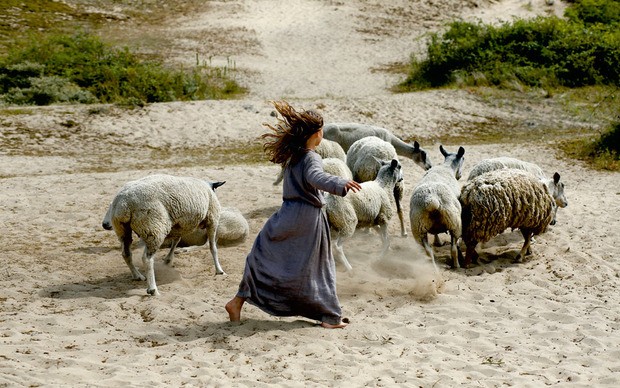
Jeannette, l’enfance de Jeanne d’Arc
One of the most peculiar films in this year’s Wavelengths program, Bruno Dumont’s Jeannette, l’enfance de Jeanne d’Arc alternates between lengthy philosophical disquisitions on perdition and heavy metal musical numbers featuring head-banging nuns and a breakdancing peasant. As the story opens, Jeannette (Lise Leplat Prudhomme) is outwardly happy and secure in her faith but confides to her friend, Hauviette (Lucile Gauthier), that her heart is heavy because God has not answered the prayers of the French people, who have been at war with the British for more than fifty years. Seeking guidance, Jeannette summons Madame Gervaïse, who turns out to be not one but two nuns (Aline and Elise Charles) who function as a unit, completing each other’s sentences and frequently speaking in unison like the twins from The Shining (Stanley Kubrick, 1980). Five years later, with the British on the cusp of victory, Jeanne (Jeanne Voisin) belatedly decides to accept the mission God has given her and enlists her rat-faced uncle (Nicolas Leclaire) to help her run away from home. As the title may suggest, the film focuses on the heroine’s life before she actually does anything, with the Beckett-like plot largely confining itself to a single hillside where Jeannette/Jeanne brings her sheep to graze. And in contrast with Dumont’s great Hors Satan (2011), which attempted to make the supernatural seem real, here the contemporary music and theatrical dialogue foreground the impossibility of a 21st century viewer having unmediated access to the life of Jeanne d’Arc. To paraphrase David Bordwell in another context, Jeanette refuses to be a great film, and yet, I could not stop watching it.
Relative to the other films in this year’s Wavelengths program, the most striking thing about Neïl Beloufa’s Occidental is how classical it seems, both in terms of its storytelling and its mise en scène. Set entirely in and around a kitschy, retro-1970s hotel adjacent to a massive street demonstration and unfolding largely in real time, the story centres on two men claiming to be Italians (Idir Chender and Paul Hamy) who check into the honeymoon suite and then keep coming down to the lobby for cokes—raising the suspicions of the hotel’s no-nonsense night manager, Diana (Anna Ivacheff), who has been on the job long enough to know that Italians never drink coke. The title, which is also the name of the hotel, suggests that Beloufa intends this story as an allegory for the state of contemporary Europe, but the film works best simply as a dark comedy. (Louise Orry-Diquéro, who looks like Greta Gerwig mashed into Ludivine Sagnier, is particularly delightful as the hotel’s ditzy receptionist, Romy, who loses her head completely when one of the fake Italians flirts with her a little.) Clocking in at a mere 73 minutes, the film has the sort of narrative economy one associates with the best Val Lewton B films of the 1940s, and Beloufa gets a lot of mileage out of the hotel’s architectural features, which isolate the characters in Sirkian frames within frames so that the destruction of the hotel at the end of the film feels like a liberation.
Schema and RevisionWhile much writing on Direct Cinema has focused on the form’s claims to represent reality objectively (see Nichols, 17-21), few commentators have considered the observational documentary purely as a set of inherited schemata which individual filmmakers may adhere to, revise, or reject outright (Bordwell, 152-155). 1 Emmanuel Gras’ Flaherty-esque Makala is a largely conventional example of the genre, dogging a Congolese charcoal maker, Kabwita Kasongo, as he undertakes the Sisyphean task of transporting several huge sacks of charcoal from his home village to the nearest market—which is over fifty kilometres away—on a rickety bicycle. But while the film has many of the strengths one typically associates with Direct Cinema (a unified narrative centering on a sympathetic protagonist, a lack of overt preachiness), it also has virtually all of the drawbacks: Not only does the film fail to situate Kasongo’s story within a broader social context, but it comes close to abstracting him from history altogether, turning him into the Timeless African Man of Sarkozy’s imagination. Indeed, when Kasongo finally arrives in the city, the blaring ambient noise of traffic and crackling radios is a startling contrast to the peaceful rustling of the leaves in his village, suggesting that the problem Africa faces today is not too little development but too much. But worse than that, the story does not go anywhere.
If Gras seems content not to reinvent the wheel, Wang Bing evidently aspires to a level of realism not attainable by earlier documentary filmmakers, marrying the fly-on-the-wall voyeurism of Direct Cinema with a Warholian long-take aesthetic—a combination that was unfeasible prior to the advent of digital video. However, on the evidence of Ta’ang (2016) and now Mrs. Fang, I am not convinced that Wang has a clue about how to tell a story. The subject of the latter film, Fang Xiuying, is an elderly woman from a remote village in Zhejiang province with advanced-stage Alzheimer’s, and Wang alternates between extended close-ups of Fang’s immobile face and long shots of her family members standing around her bed and talking about her as if she was already dead, arguing about which burial site has the best feng shui and whether or not they should call Fang’s grandson immediately in case she does not survive the night. As an intimate glimpse into how a more or less typical Chinese family deals with the impending death of one of its members, the film is sociologically fascinating, but scenes like the one in which Fang’s brother-in-law goes fishing in the middle of the night with his drinking buddies seem unnecessary and shapeless. It is as if Wang believes that any activity is inherently compelling onscreen as long as one records it for an extended duration of time.
A more disciplined specimen of Chinese cinema screened at this year’s festival, Shi Dongshan’s silent Struggling (1932) was made shortly after the Japanese invasion of Manchuria and its melodramatic story can be read as an allegory for the nation. The plot centres on two factory workers, Xiao Zheng (Zheng Junli) and Xiao Yuan (Yuan Congmei), who live in a boarding house where the corpulent owner mistreats his adoptive daughter, Swallow (Chen Yanyan). When the owner tries to sell Swallow to an unsavoury old man, Xiao Zheng gallantly comes to her rescue, first hiding her in the room he shares with Xiao Yuan—who has designs of his own on Swallow—and then running away with her to an unspecified city where Xiao Yuan eventually tracks them down. Like the nation at large, Swallow needs to be defended with manly strength, and when war breaks out in the second half of the film, Xiao Zheng is unsurprisingly eager to enlist.
Of course, this being a melodrama, Swallow becomes literally sick with worry that Xiao Zheng will die on the battlefield, recalling Peter Brooks’ observation that the hystericized body offers a key emblem of the convergence of melodrama and psychoanalysis as “it is a body preeminently invested with meaning—a body that has become the place for the inscription of highly emotional messages that cannot be written elsewhere, and cannot be articulated verbally” (xi). The convulsive intensity of the characters’ emotions may help to explain the surprising power of the film’s final scene, as the viewer cannot help but mimic the emotions of the characters onscreen, albeit in a weakened form (Smith, 98-102). In short, the film suggests that melodrama offered a useful schema to Chinese directors looking for ways to contribute to the war effort; by conflating the waifish heroine with the nation, Shi is able to elicit a stronger emotional response from the viewer than he could through a purely impersonal appeal to patriotism. Pinho should take note.
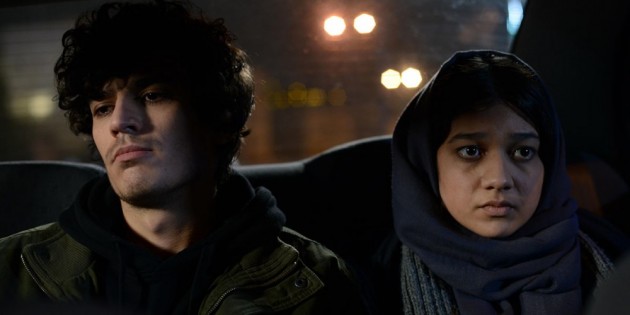
Disappearance
In the thirty years since the films of Abbas Kiarostami and Mohsen Makhmalbaf first made a splash at European festivals, western cinephiles have come to expect certain things from Iranian art house films: stories set largely or exclusively in public spaces, protagonists single-mindedly pursuing concrete goals and hitting obstacles at every turn, delayed exposition, highly compressed time frames, a realist mise en scène, virtuoso long takes, themes of roleplay, and lots of driving. Ali Asgari’s debut feature, Disappearance, departs from this Platonic ideal of the Iranian Art Film only in that its story downplays class issues in favour of an emphasis on bureaucratic obstructionism that calls to mind recent Romanian cinema. Beginning in medias res, the film opens with a university student, Sara (Safar Asgari), walking into a hospital and telling the head nurse that she was raped by a taxi driver. The nurse asks her to call a family member, and soon after, her “brother,” Hamed (Amir Reza Ranjbaran), turns up at the hospital and starts shouting at the nurse when she tells him Sara’s story. However, as soon as the nurse is out of earshot, Sara begins critiquing Hamed’s performance, saying he is overdoing the protective older brother routine. And when the hospital insists that Hamed present identification proving his relationship to Sara before they operate on the tear in her vagina, the two young people head out into the night in search of a clinic that is more casual about bureaucratic procedure. As this plot description may suggest, the film provides the viewer with just enough information about the characters to want to know what will happen to them (i.e., will Sara get the surgery she needs before she bleeds to death?), while at the same time arousing one’s curiosity about the circumstances that brought them to this juncture—something the viewer only gradually pieces together. A very skillful debut that held my attention from start to finish, the film demonstrates that if certain devices become conventions it is usually because they work.
A more inventive recasting of neorealist tropes, Antonio Méndez Esparza’s Life and Nothing More marries the traditional subject matter of kitchen sink realism with an uninflected long take style that places equal emphasis on each scene. At first glance, the film seems to be a series of discrete, everyday events in the life of a single mother, Regina (Regina Williams), who works at a truck stop diner in Tallahassee, Florida to support her two kids. Gradually, however, two major narrative lines begin to emerge from the accumulation of daily scenes: the worsening behaviour of Regina’s teenage son, Andrew (Andrew Bleechington), which dominates the first and last third of the film, and her romantic involvement with a regular customer at the diner, Robert (Robert Williams), which is the focus of the film’s middle section. Esparza films the majority of scenes in a single long take from a stationary camera, and combined with the elliptical narrative, the film’s dispassionate gaze precludes the viewer from making snap judgements about the characters. In particular, while Regina is initially suspicious of Robert’s intentions, Williams’ performance does not betray any sign of expressive incoherence that would signal to the viewer that Robert is putting on a mask (Naremore, chapter 4). Furthermore, when Regina and Robert have their first fight, the viewer only learns of it in retrospect when Andrew asks Robert what happened and one never finds out what the argument was about, making it impossible for the viewer to assess how serious the fight was or who was at fault. As a result of its elliptical storytelling and unemphatic style, the film’s ending never seems like a foregone conclusion, as it does in some films by Ken Loach (e.g., Sweet Sixteen [2002]), where the protagonist’s defeat is so overdetermined as to seem inevitable; here, events simply happen, suggesting that things need not necessarily have turned out this way. All in all, this is a lovely piece of work.
One of the most singular directors working today, Hong Sangsoo has not only carved out a distinctive niche within the Asian minimalist school but also continues to devise fresh strategies for roughening form, proving that there are an infinite number of ways to make the same film over and over. In last year’s Yourself and Yours (2016), the viewer could not be certain if the woman claiming to be the heroine’s twin was telling the truth or if she was actually the heroine pretending to be her own sister, while in The Day After, Hong contrives to make the viewer confuse two characters played by different actresses. (Spoilers ahead.) The new film centres on a middle-aged publisher, Bongwan (Kwon Haehyo), whose wife, Haejoo (Cho Yunhee), suspects that he is having an affair, though in fact he broke off his relationship with a former employee, Changsook (Kim Saebyeok), over a month ago. Moving back and forth in time, the film does not provide the usual signposts by which films typically distinguish past from present (printed titles, contrasting colour schemes, etc.), so when Areum (Kim Minhee) shows up for her first day of work, some viewers may take this scene—as I did—for a flashback to the beginning of Bongwan’s affair with Changsook. Accordingly, when the film cuts from a shot of Areum (who has long hair and wears a black sweater) gently chastising Bongwan for his cowardice to a shot of Changsook (who has short hair and wears a white sweater) crying and calling him a coward, one may confuse the two women for the same person at different times, either not noticing that they are played by different actresses or rationalizing this anomaly as a deliberate artistic choice underscoring Areum/Changsook’s split personality (calm one moment, hysterical the next). Therefore, when Haejoo confronts Areum with her suspicions, the viewer is as surprised as she is when Areum tells her that this is only her first day on the job. The Day After is a comedy in which the joke is as much on the viewer as it is on the characters.
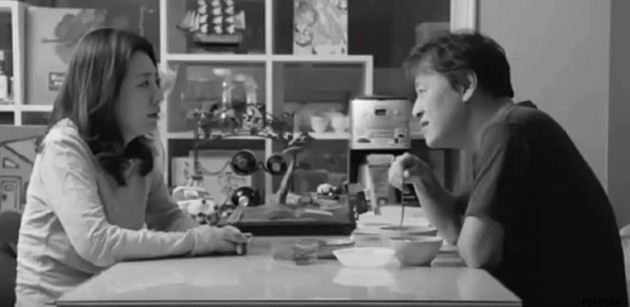
The Day After
In Russ Meyer’s Beyond the Valley of the Dolls (1970), there is a sequence in which two of the characters debate whether or not they should move to Los Angeles over a series of disconnected images illustrating their respective arguments (e.g., when one of the characters says pessimistically, “We’ll be crushed,” Meyer cuts to a shot of a man stepping on an egg). I do not know if Sara Cwynar was thinking of this sequence when she made Rose Gold—which has no eggs, at least that I can recall—but the film’s pop art colour scheme, fetishistic close-ups, iconic American landscapes, and rhythmic editing are all reminiscent of Meyer at his most delirious without ever seeming slavishly imitative. Linking its images associatively and abstractly, the film is a giddy montage of ceramic tea cups, cracked electronic devices, landline phones, vintage magazine ads enlarged beyond recognition, and glimpses of a Las Vegas hotel and the Grand Canyon (among other things) accompanied by a profusion of short fragments of speech reflecting critically on the consumer culture that Cwynar’s eye-catching images seem to exalt. As this description may suggest, the film breaks its theme down into its smallest components so that, as in Soviet montage cinema, their juxtaposition creates in the viewer’s imagination a total impression (Eisenstein, 17).
Speaking of montage-based delirium, Hélène Cattet and Bruno Forzani’s baroque pulp thriller Laissez bronzer les cadavres offers a barrage of graphically and rhythmically discontinuous images—including a great many Leone-like extreme close-ups accompanied by Mickey Mouse sound effects—that suggest violent action more than show it. Based on a 1971 roman noir by Jean-Pierre Bastid and Jean-Patrick Manchette (which I cannot wait to read), the absurdly convoluted plot centres on a gang of armed robbers whose plan to hold up an armoured van transporting gold bars goes horribly awry when they stop to pick up a female hitchhiker, who it turns out also knows the bored bohemian couple the robbers are summering with in an arid corner of Western Europe. I could not always keep track of who was double-crossing whom (the short answer seems to be: everyone and anyone, respectively), though I am not sure it matters all that much; exceeding even the work of Quentin Tarantino in its anti-humanist formalism, the film compares its characters to ants crawling over an aerial photograph and the flesh of a dead pig when it is not suggesting that they are fundamentally interchangeable, like a limited set of words that can be rearranged to produce new sentences. (At one point, a title card signalling a jump forwards or backwards in time bridges two identically framed shots of different characters staring at the same skull.) As in Cocote, the plot is primarily a means of motivating a series of stunning set pieces, including several trippy fantasy sequences in which a sexy black woman has her clothes ripped to shreds by machine gun fire and champagne gushes from the nipples of a naked white woman tied to a wooden X, among other things. In short, the most exciting avant-garde film I saw at this year’s festival was not to be found in the Wavelengths program but Midnight Madness.
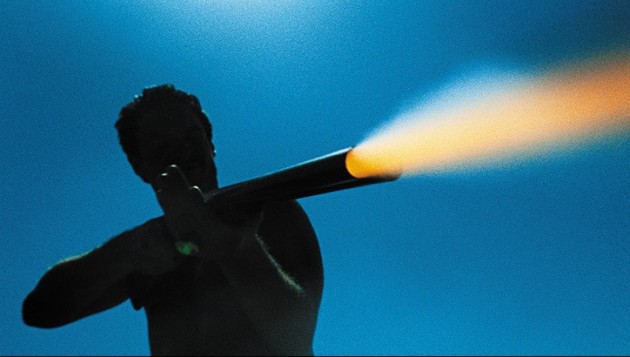
Laissez bronzer les cadavres
On the other hand, the most pleasurable narrative film I saw at the festival was Valeska Griesbach’s Western, which is masterful in the way that it plays with the audience’s expectations. The film’s protagonist, Meinhard (Meinhard Neumann), is part of a German construction crew working on an infrastructure project in Bulgaria adjacent to a small village where the locals regard them as an occupying force. But while Meinhard’s interactions with the townspeople are initially somewhat fraught, in part because he does not speak the language, he gradually manages to ingratiate himself to the community by treating them with respect. So naturally the viewer is constantly waiting for relations between the two sides to sour over some misunderstanding or another, especially as the crew’s foreman, Vincent (Reinhardt Wetrek), seems to go out of his way to tick off the townspeople, aggressively flirting with a local woman when she goes swimming in a river near the site and unilaterally redirecting the town’s rationed water supply during a drought so that the work can continue. Yet, miraculously, each situation turns out in a way that is totally unexpected and at the same time perfectly logical. In one sequence, Meinhard is walking back to the site late at night after cleaning up at the poker table when a young boy jumps him as a joke, and the former (an ex-legionnaire) responds instinctively by knocking the boy out cold. One expects this to be the start of an all-out war between the Germans and the townspeople, but when the boy’s uncle finds out what happened, he thinks the boy deserved to get hit. That said, the film would not work as well as it does if Meinhard were not an uncommonly sympathetic protagonist; unlike Dumont, who seems incapable of truly believing in Jeanne d’Arc, Griesbach has the nerve to create a character who is fundamentally decent. This was one of the very few films I saw at TIFF this year that made me care deeply about its characters.
Bibliography
Bordwell, David. On the History of Film Style. Cambridge: Harvard University Press, 1997. Print.
Brooks, Peter. The Melodramatic Imagination: Balzac, Henry James, Melodrama, and the Mode of Excess. New Haven: Yale University, 1995. Print.
Eisenstein, Sergei. The Film Sense. Ed. & trans. by Jay Leyda. New York: Meridian Books, 1957. Print.
Naremore, James. Acting in the Cinema. Berkeley: University of California Press, 1988. Print.
Nichols, Bill. “The Voice of Documentary.” Film Quarterly, vol. 36, no. 3 (1983): 17-30. Print.
Ruoff, Jeff. “Conventions of Sound in Documentary.” Cinema Journal, vol. 32, no.3 (1993): 24-40. Print.
Smith, Murray. Engaging Characters: Fiction, Emotion, and the Cinema. Oxford: Claredon Press, 1995. Print.
Thompson, Kristin. Breaking the Glass Armor: Neoformalist Film Analysis. Princeton: Princeton University Press, 1988. Print.
Notes
- Jeff Ruoff’s article, “Conventions of Sound in Documentary,” is a notable exception. ↩




